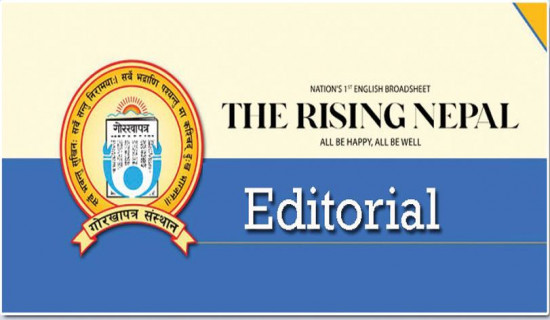- Thursday, 22 January 2026
Monsoon Preparedness
Nepal is on high alert for the upcoming monsoon season, as meteorological experts predict there will be more rain than usual, which could lead to disasters like floods, landslides and faster snowmelt. The weather is also expected to be hotter than normal, making these risks even worse. The latest forecast by the Department of Hydrology and Meteorology depicts a worrisome scenario. While the prospect of above-normal rainfall across most parts of the country is like a boon for the agriculture-dependent economy, it also raised red flags regarding the potential risk of natural disasters.
According to the prediction, there is a 35 to 55 per cent chance of higher-than-average precipitation in most regions, with some areas expected to receive rainfall exceeding normal levels by a staggering 35.4 to 65.5 per cent. Additionally, both maximum and minimum temperatures are predicted to be higher than usual, exacerbating the risk of weather-related calamities. For a country like Nepal, where a significant portion of the population relies on agriculture for their livelihood, a bountiful monsoon can indeed be a blessing. Adequate rainfall not only boosts crop yields but also replenishes water reservoirs and aquifers, ensuring a steady supply of water for irrigation and hydropower generation.
This can translate into increased rural incomes, driving consumer spending and overall economic growth. However, the flip side of the coin should not be ignored. Nepal’s rugged terrain and fragile topography make it highly vulnerable to monsoon-induced disasters. Intense rainfall, especially when concentrated over short periods, can trigger devastating landslides that claim lives, destroy infrastructure, and wreak havoc on human settlements. Similarly, low-lying areas in the Tarai region face the annual threat of floods, displacing thousands of people and causing immense damage to property and livelihoods.
While the government and relevant authorities must prioritise disaster preparedness and early warning systems, it is equally crucial to address the broader issue of climate change mitigation and adaptation. The unpredictable weather patterns and fluctuation in rainfall intensity are stark reminders of the profound impact human-induced climate change is having on our environment. Proactive measures must be taken to strengthen infrastructure, implement sustainable land-use practices, and promote climate-resilient agriculture. Investing in robust early warning systems, effective disaster response mechanisms, and community-level preparedness can help minimise the loss of life and property during extreme weather conditions.
Furthermore, it is imperative to raise public awareness about the dangers associated with monsoon-related disasters and educate communities on how to respond effectively and promptly to such situations. Empowering citizens with the knowledge and resources to take appropriate precautions can reduce the risk. As Nepal prepares for the upcoming rainy season, it is important to find a balance. We need to make the most of the extra rain while also being ready to mitigate the risks posed by the extreme weather. Comprehensive planning, robust disaster management strategies, and a concerted effort towards climate change adaptation are essential. It will be key to ensuring that the monsoon remains a blessing for economic growth rather than a threat to life and property.

















